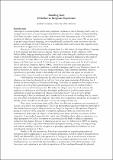Smelling God : olfaction as religious experience
Abstract
Although it is commonplace within many religious traditions to talk of ‘hearing God’s voice’ or ‘seeing God at work,’ or even ‘being touched by God,’ it is less common to talk of people using olfactory language, even metaphorically, to describe their encounters with the divine, even though, if God is immaterial, it is surely true that God no more has a specific scent than he does an appearance or a sound. Yet, as this chapter will explore, there is a rich history of thinking of the olfactory sense in relation to religious experience. The chapter begins by exploring the role of olfactory experience in the Christian tradition; here we see the prominence of non-metaphorical descriptions of olfactory religious experience from a number of sources. However, a cursory glance at contemporary philosophical work on the nature of religious experience demonstrates that philosophy of religion has typically excluded olfactory experiences from their analyses of religious experience. This chapter offers a contemporary, non-metaphorical account of olfactory religious experience which draws from work in the philosophy of smell, and the cognitive penetration of perception.
Citation
Cockayne , J L 2019 , Smelling God : olfaction as religious experience . in B Hereth & K Timpe (eds) , The Lost Sheep in Philosophy of Religion : New Perspectives on Disability, Gender, Race, and Animals . vol. Routledge , Routledge Studies in the Philosophy of Religion , pp. 97-119 . https://doi.org/10.4324/9780429022531-5
Publication
The Lost Sheep in Philosophy of Religion
Type
Book item
Description
The Templeton Religion Trust is acknowledged for their generous funding during the writing of this paper.Collections
Items in the St Andrews Research Repository are protected by copyright, with all rights reserved, unless otherwise indicated.

